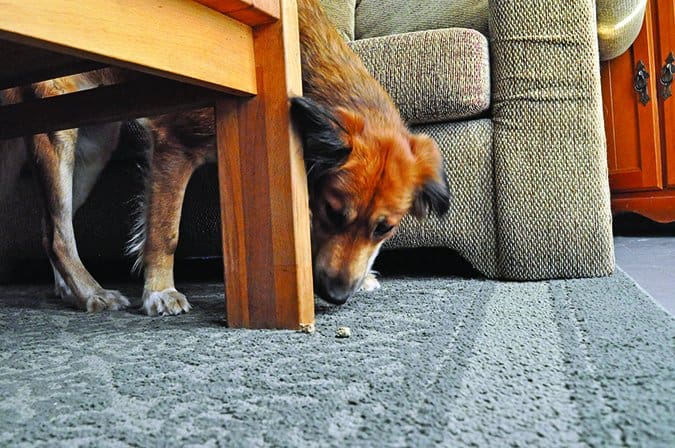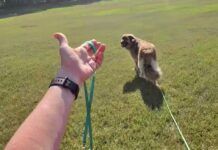1. Teach your dog a “Find it” cue by dropping a tasty treat on the ground and telling your dog to “Find it!” (I tell my clients this is the easiest thing they will ever teach their dogs.) Repeat several times until your dog’s eyes light up when she hears the cue.
2. Have her sit or lie down, and tell her to “Wait” or “Stay” or have someone hold her collar if she won’t wait when you ask her to. Walk a few paces away and show her a treat. Place it on the ground as you remind her to wait. Return to her side, face the treat, and release her with your “Find it!” cue. Encourage her, if necessary, to run out and eat the treat.
3. Repeat Step 2 several times, and then let her watch you hide a treat in “easy” hiding places – behind the leg of a chair, under the coffee table, etc.

4. After several successful finds, let her watch you hide two treats, then three treats, in easy places. During this step, start rubbing the treat on a paper towel and ask her to “sniff” before you tell her to “Find it.”
5. Next, let her watch you hide treats in harder places – on elevated surfaces, under things, and behind things. Continue to ask her to sniff the scented paper towel before sending her to “Find it.”
6. Now it gets really fun. Put your dog in another room while you hide several treats. Then bring her back in the room, let her sniff the paper towel, and tell her to “Find it.” Don’t help her! The whole idea is that she has to work hard with her nose to find the treats. If she can’t find one or more after searching for some time, remove her from the room, pick up the hidden treats, and try again with the treats in easier places.
When your dog has learned how to search, this makes a great rainy day indoor exercise activity. You can also routinely scatter her meals around the yard so she has to search through the grass to find them; put her on a long line if you don’t have a fence. You can also name her favorite toys and have her find them. You can even have family members and friends hide and have her find them. (Use their name and a scented clothing article with your “Sniff,” “Find Joey” cues.)






